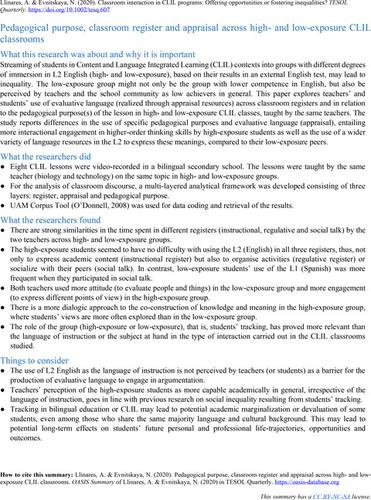Our official English website, www.x-mol.net, welcomes your
feedback! (Note: you will need to create a separate account there.)
Classroom Interaction in CLIL Programs: Offering Opportunities or Fostering Inequalities?
Tesol Quarterly ( IF 3.0 ) Pub Date : 2020-07-13 , DOI: 10.1002/tesq.607 Ana Llinares 1 , Natalia Evnitskaya 2
Tesol Quarterly ( IF 3.0 ) Pub Date : 2020-07-13 , DOI: 10.1002/tesq.607 Ana Llinares 1 , Natalia Evnitskaya 2
Affiliation

|
This study investigated potential inequalities in a bilingual education program where secondary school students are streamed into two strands with different degrees of exposure to the target language based on their proficiency: high exposure (HE) and low exposure (LE). Drawing on classroom registers (Christie, 2005), appraisal theory (Martin & White, 2005), and sociocultural perspectives on classroom interaction (Gibbons, 2006; Lemke, 1989; Mortimer & Scott, 2003), researchers analysed interactional practices by teachers teaching the same content in both groups. Results show no major differences in distribution of classroom registers and teachers’ general pedagogical purposes across groups. Analysis of students’ language use across registers corroborates previous studies showing that translanguaging in content and language integrated learning is more common when the focus is on classroom management issues (e.g., Moore & Nikula, 2016). The most striking results relate to differences in use of pedagogical purposes and evaluative language. These differences entail more interactional engagement in higher order thinking skills by HE students and use of a wider variety of language resources in the second language (L2) to express these meanings, compared to LE students. This indicates that the division into strands in bilingual programs may lead to different perceptions of students’ academic capacities beyond L2 proficiency and reinforcement of social differences and inequality in bilingual programs.
中文翻译:

CLIL 课程中的课堂互动:提供机会还是助长不平等?
本研究调查了双语教育计划中的潜在不平等,在该计划中,中学生根据他们的熟练程度被分为两种不同程度的目标语言:高接触 (HE) 和低接触 (LE)。利用课堂记录(Christie,2005)、评估理论(Martin & White,2005)和课堂互动的社会文化观点(Gibbons,2006;Lemke,1989;Mortimer & Scott,2003),研究人员分析了教师教授课堂互动的互动实践。两组内容相同。结果表明,各组之间课堂名册的分布和教师的一般教学目的没有重大差异。对学生跨语域语言使用的分析证实了之前的研究表明,当关注课堂管理问题时,跨语言整合学习在内容和语言综合学习中更为常见(例如,Moore & Nikula,2016)。最显着的结果与教学目的和评价语言的使用差异有关。与 LE 学生相比,这些差异需要 HE 学生在更高层次的思维技能方面进行更多的互动参与,并使用更广泛的第二语言 (L2) 语言资源来表达这些含义。这表明双语课程中的分支可能会导致对学生超出 L2 熟练程度的学术能力的不同看法,并加剧双语课程中的社会差异和不平等。
更新日期:2020-07-13
中文翻译:

CLIL 课程中的课堂互动:提供机会还是助长不平等?
本研究调查了双语教育计划中的潜在不平等,在该计划中,中学生根据他们的熟练程度被分为两种不同程度的目标语言:高接触 (HE) 和低接触 (LE)。利用课堂记录(Christie,2005)、评估理论(Martin & White,2005)和课堂互动的社会文化观点(Gibbons,2006;Lemke,1989;Mortimer & Scott,2003),研究人员分析了教师教授课堂互动的互动实践。两组内容相同。结果表明,各组之间课堂名册的分布和教师的一般教学目的没有重大差异。对学生跨语域语言使用的分析证实了之前的研究表明,当关注课堂管理问题时,跨语言整合学习在内容和语言综合学习中更为常见(例如,Moore & Nikula,2016)。最显着的结果与教学目的和评价语言的使用差异有关。与 LE 学生相比,这些差异需要 HE 学生在更高层次的思维技能方面进行更多的互动参与,并使用更广泛的第二语言 (L2) 语言资源来表达这些含义。这表明双语课程中的分支可能会导致对学生超出 L2 熟练程度的学术能力的不同看法,并加剧双语课程中的社会差异和不平等。











































 京公网安备 11010802027423号
京公网安备 11010802027423号